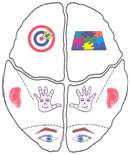Sensory Preference Continuum
©Arlene R. Taylor PhD
Human beings interact with each other and with the environment through the senses. Growing up you likely learned to group sensory data into one of three categories:
- Visual
- Auditory
- Kinesthetic
Unimpaired you can input and decode the entire range of sensory stimuli, although one sensory system may be used more than the other two in a specific situation.
Some models portray the sensory systems in mixed combination with other types of brain functions. I perceive them as separate overlays (refer to the Who I Am Pyramid model for more information).
Sensory Decoding
Most sensory data are decoded in the 3rd brain layer, in the six posterior lobes of the cerebrum, the Maintaining and the Harmonizing divisions.
These centers can receive and decode up to 10 million bits of data per second—far more than you are capable of processing at a level of conscious awareness.
 The six posterior lobes are:
The six posterior lobes are:
-
Two occipital lobes that decode data absorbed through sight
-
Two temporal lobes that decode data absorbed through sound
-
Two parietal lobes that decode kinesthetic data (e.g., taste, touch, smell, position, physical stimuli)
Note: Odors are thought to be decoded in the mammalian brain layer. The nose is only one synapse away from the amygdalae in the emotional brain. Perhaps this accounts for the fact that odors can often trigger recall of memory faster than either sight or sound.
Sensory Preference
The term Sensory Preference refers to the type of sensory data that registers most quickly and intensely in your brain.
Sensory preference may be observed from birth or before in some individuals (e.g., kinesthetic babies sucking a thumb in utero; kinesthetic babies touching anything that is soft such as the satin border on a blanket, or being especially sensitive to the feel of something against their skin, or being very sensitive to odors or flavors).
By pre-kindergarten age, sensory-preferent behaviors can be observed in most children.
Sensory preference impacts the way you take in and process sensory data, your comfort level in any given situation, how you learn new information best, and the way in which you interact with others and with the environment. You tend to feel affirmed, comfortable, and understood when you receive sensory data in your sensory preference. Typically you will expend less energy when decoding data that matches your sensory preference.
Incidence
Estimates are that sensory preference is found in the general population as follows:
|
Auditory Preference - 20% |
Visual Preference - 60% |
Kinesthetic Preference - 20% |
| More females than males when tallied by gender
Who takes data in through the ears most easily? |
More males than females when tallied by gender
Who takes data in through the eyes most easily? |
Equal females and males when tallied by gender
Who takes data in via taste, touch, and smell most easily? |
-
Visuals – tend to take data in most energy-efficiently through sight (e.g., what comes in through the eyes)
-
Auditories – tend to take data in most energy-efficiently through sound or reading
-
Kinesthetics – tend to take data in most energy-efficiently through taste, touch, smell, muscle and position sense, and temperature perception
Unusual Decoding
Sometimes sensory data is misrouted to the incorrect decoding center. This phenomenon may be related to hallucinations. Think of them as intense, self-generated experiences involving one or more of the senses. Studies show that the voices heard by individuals diagnosed with schizophrenia are their own. Speech is generated in one part of the brain but experienced as auditory input in another part.
Sometimes hallucinations are the result of giftedness. Individuals with eidetic (photographic) memory are more likely to experience hallucinations than are others. For example, children who play with seemingly invisible (to others) playmates may actually be seeing these playmates as clearly as the rest of us see real people.
States of Consciousness and the Senses
Markova, in her book The Open Mind, Exploring the Six Patterns of Natural Intelligence, describes three states of consciousness: conscious, subconscious, and unconscious. She claims that these states can be triggered by any of the sensory systems and that differing mental processes are activated depending on the specific type of sensory stimuli involved.
For example:
-
Visual stimuli – the conscious learns most easily by seeing and watching, the subconscious by seeing things from two directions to help sort out the thoughts, and the unconscious by seeing the whole of the thing
-
Auditory stimuli – the conscious learns most easily by listening, discussing, and talking, the subconscious by talking to help sort out the thoughts, and the unconscious by hearing the whole of the thing
-
Kinesthetic stimuli – the conscious learns most easily by moving and doing, the subconscious by movement to help sort out the thoughts, and the unconscious by sensing the entirety of the thing


